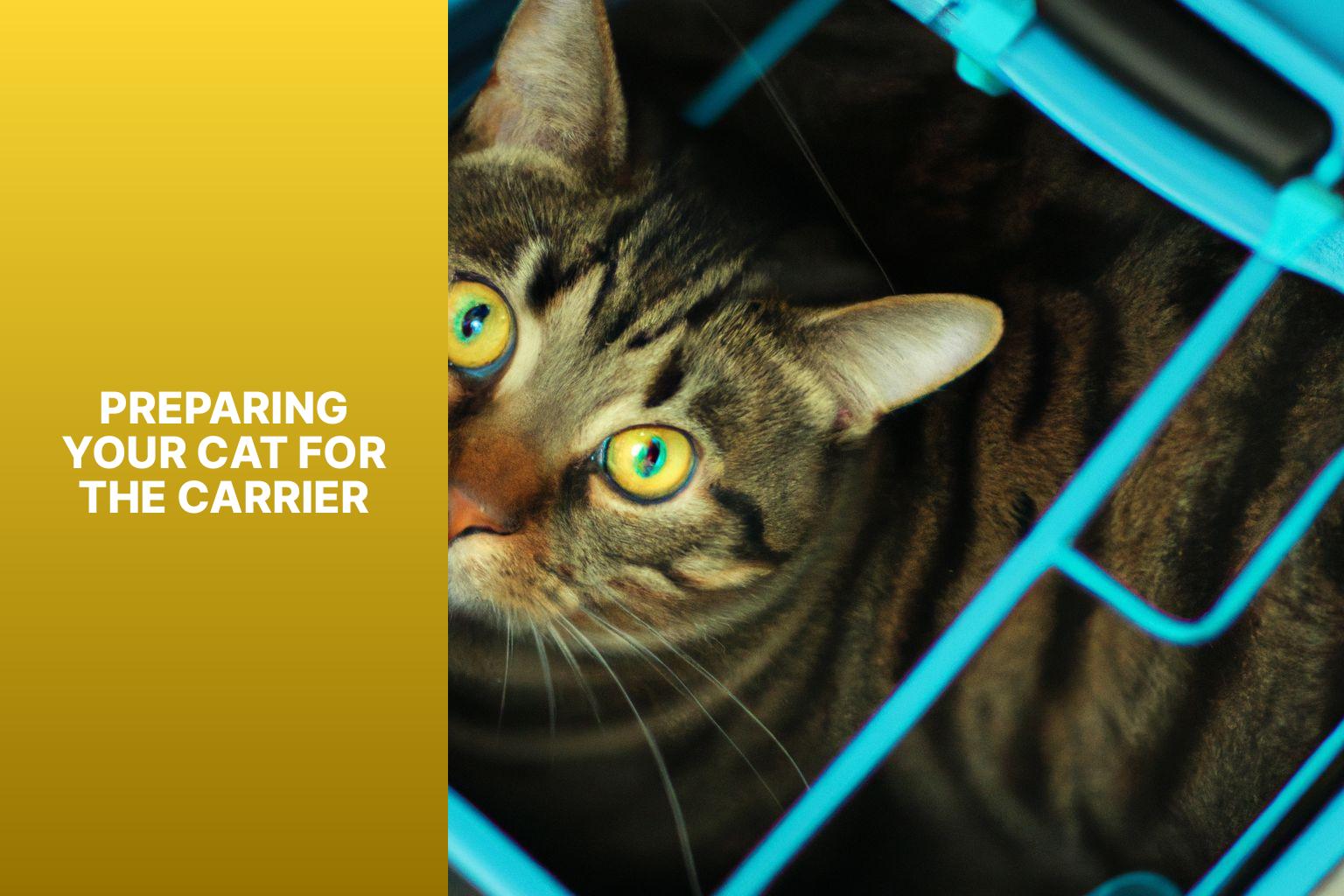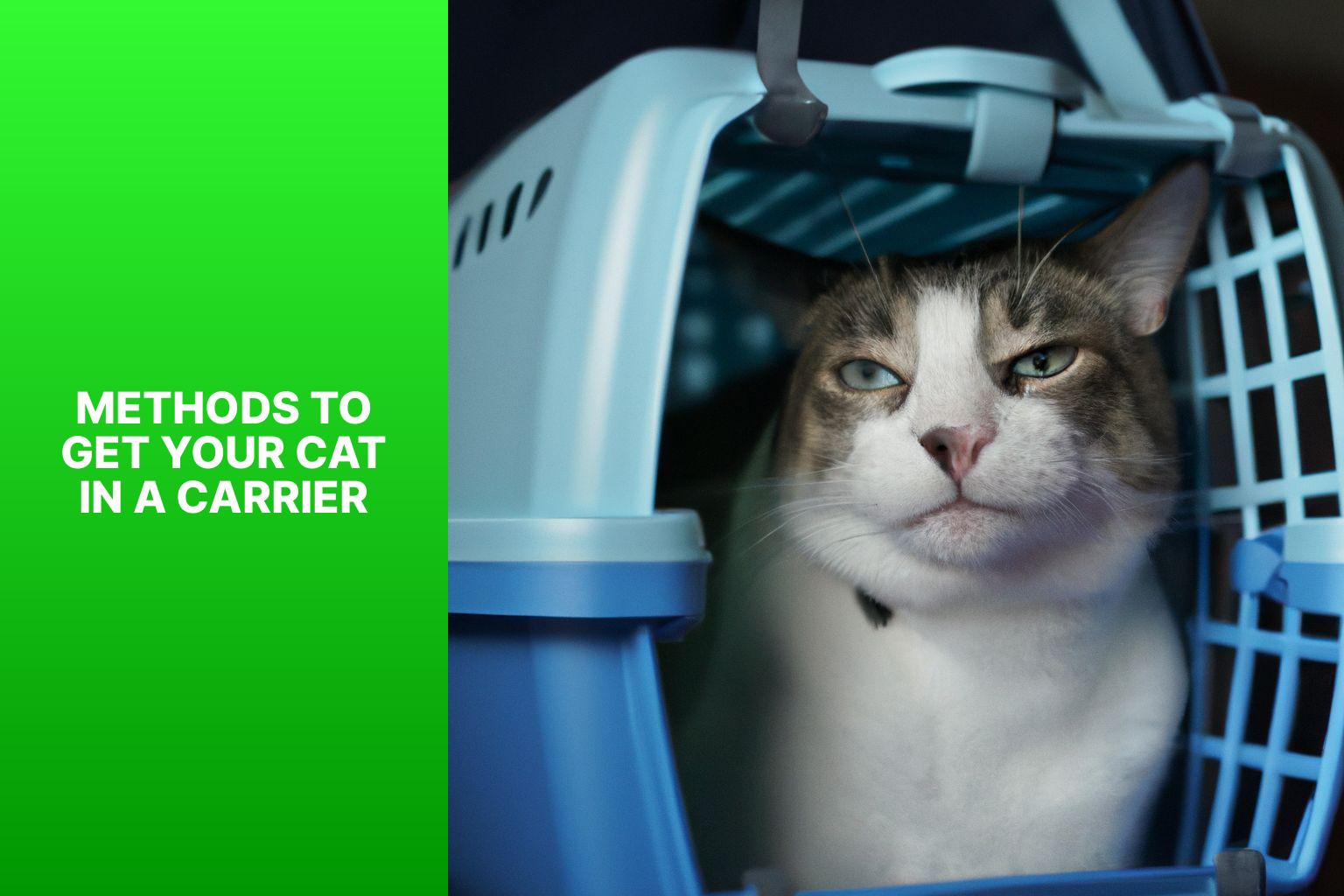Getting your cat into a carrier can be a challenging task, and many cat owners can relate to the struggle. Whether it’s for a trip to the vet or a travel adventure, safely transporting your feline friend in a carrier is essential. Understanding why you may need to get your cat in a carrier and how to prepare them for the experience is crucial for a stress-free and successful outcome.
The primary purpose of getting your cat in a carrier is to ensure their safety during transportation. It protects them from potential injuries and prevents them from escaping, especially in unfamiliar environments. Using a carrier reduces stress and anxiety for both you and your cat, providing a secure and comfortable space throughout the journey.
To prepare your cat for the carrier, there are a few steps you can take. First, familiarize your cat with the carrier by introducing it gradually and allowing them to explore it at their own pace. Creating a positive association with the carrier is also essential, using treats and rewards to make it an enjoyable and rewarding experience for your cat.
When it comes to actually getting your cat into the carrier, there are several methods you can try. The gentle approach involves coaxing your cat into the carrier using patience and treats. The towel technique involves wrapping your cat in a towel to gently guide them into the carrier. The dry run method involves practicing the process without actually closing the carrier, gradually building up to secure transport.
To ensure a stress-free experience, maintaining a calm atmosphere is crucial. Using pheromone sprays or diffusers can help create a relaxing environment. It’s important to avoid force or punishment when trying to get your cat into the carrier, as this can worsen their resistance and create negative associations.
If your cat continues to be resistant, there are alternative options to explore, such as seeking guidance from a professional trainer or considering alternative transportation methods. Ultimately, the goal is to prioritize the well-being and safety of your cat throughout the process.
Key takeaway:
- Getting your cat in a carrier is important: Using a carrier ensures your cat’s safety during travel, visits to the vet, or emergencies.
- Prepare your cat for the carrier: Familiarize your cat with the carrier by letting them explore it and create positive associations through treats and rewards.
- Methods for getting your cat in a carrier: Use the gentle approach, towel technique, or the dry run method to safely and calmly place your cat in the carrier.
Key takeaway:
- Ensure a stress-free experience: Maintain a calm atmosphere during the process, use pheromone sprays or diffusers, and avoid using force or punishment.
- If your cat is resistant: Try different techniques, be patient, and seek professional help if necessary.
- Final thoughts: Getting your cat in a carrier can be challenging, but with proper preparation and patience, it can be a safer and less stressful experience for both you and your cat.
Why You May Need to Get Your Cat in a Carrier
“Ensuring the safety of your cat during transportation is crucial, which is why you may need to get them in a carrier. This not only prevents escapes and injuries but also provides a secure and comfortable space, ultimately reducing their stress levels while traveling. Using a carrier makes it easier to transport your cat to and from the veterinarian, preventing any accidents or incidents that may occur if they are allowed to roam freely. In the case of emergencies or natural disasters, having your cat in a carrier allows for a quick evacuation to a safe location. So, there are several reasons why you may need to get your cat in a carrier.”
Preparing Your Cat for the Carrier
Photo Credits: Www.Catcornerblog.Com by Ronald Allen
Preparing your cat for the carrier is an essential step in ensuring a stress-free travel experience. In this section, we’ll uncover effective techniques to ease your feline friend into accepting the carrier with open paws. From familiarizing them with the carrier to cultivating a positive association, and utilizing treats and rewards for positive reinforcement, we’ll explore tried-and-true methods to make the carrier a comfortable and inviting space for your beloved cat. Get ready to transform your cat’s carrier woes into a smooth and enjoyable journey.
Familiarize Your Cat with the Carrier
To familiarize your cat with the carrier, follow these steps:
1. Leave the carrier out: Place it in an accessible area. Keep the door open for your cat to freely explore.
2. Add bedding or familiar scents: Place a soft blanket inside with your cat’s scent. This will make your cat feel more comfortable and familiar.
3. Make it cozy: Ensure the carrier is a pleasant place. You can add toys or treats to entice your cat to enter and spend time voluntarily.
4. Increase time inside gradually: Encourage your cat to enter by placing treats or toys near the entrance. As they become more comfortable, gradually increase the time with the door closed.
5. Practice short trips: Take your cat for short car rides in the carrier. Start with brief trips around the neighborhood and gradually increase the distance.
Fact: Familiarizing your cat with the carrier reduces stress and anxiety during travel or visits to the veterinarian.
Create a Positive Association with the Carrier
Creating a positive association with the carrier is crucial for your cat’s comfort. Here are steps to help achieve this:
1. Familiarize your cat with the carrier: Leave the carrier open in a common area so your cat can investigate it at their own pace.
2. Create a welcoming environment: Place familiar items, like their favorite blanket or toy, inside the carrier.
3. Use treats and rewards: Encourage your cat to approach and enter the carrier by placing treats inside or nearby.
4. Associate the carrier with positive experiences: Place your cat’s food or toys near the carrier during playtime or mealtime.
5. Gradually increase exposure: Introduce your cat to spending short periods of time inside the carrier, starting with a few minutes and extending the duration over time.
By following these steps, you can create a positive association with the carrier for your cat, making transportation easier. Remember to be patient and allow your cat to progress at their own pace.
Use Treats and Rewards for Positive Reinforcement
When preparing your cat for the carrier, use treats and rewards to create a positive association and reinforce good behavior.
- Choose treats your cat loves and finds enticing.
- Get your cat comfortable around the carrier by placing it in a familiar, calming location in your home.
- Leave the carrier open and place treats inside to encourage your cat to explore and enter on their own.
- Each time your cat enters the carrier voluntarily, give them a treat and offer praise or gentle petting.
- Repeat this process, gradually increasing the amount of time your cat spends in the carrier and always rewarding positive behavior.
- If your cat is reluctant to enter the carrier, try placing treats just outside and gradually move them closer to the entrance.
- Consider using a clicker to mark the desired behavior and follow it with a treat to reinforce positive associations.
- Be patient and understanding as every cat is different, and it may take time for them to feel comfortable with the carrier.
Using treats and rewards for positive reinforcement can help your cat associate the carrier with positive experiences and make the process of getting them into the carrier more pleasant and stress-free.
Methods to Get Your Cat in a Carrier
Photo Credits: Www.Catcornerblog.Com by Michael Mitchell
Getting your cat into a carrier can be stressful for both you and your furry friend. But fear not! In this section, we’ll explore some effective methods that can make this task a breeze.
Discover the gentle approach, where patience and positive reinforcement come into play. Or try the towel technique, a handy trick that helps calm even the most anxious cats. And finally, we’ll uncover the secrets of the dry run method, ensuring your cat feels prepared and comfortable before the actual carrier encounter.
The Gentle Approach
The gentle approach is a recommended method to get your cat in a carrier.
Approach your cat calmly and slowly, using a soothing tone of voice.
Place the carrier in a quiet area where your cat feels comfortable.
Open the carrier door and allow your cat to explore at their own pace.
Create a positive association with the carrier by placing treats, toys, or blankets inside.
Use treats and rewards to encourage your cat to enter the carrier willingly.
If your cat is hesitant, guide them towards the carrier by placing treats near the entrance.
Avoid using force or punishment, as this can cause stress and resistance.
Remember, patience is key.
It may take time for your cat to feel comfortable entering the carrier.
By creating a positive and stress-free environment, you can gradually build their trust and make the carrier a familiar and safe space for them.
The Towel Technique
The Towel Technique helps get your cat into a carrier in a stress-free way. Follow these steps:
- Place the carrier on the floor with the opening facing up.
- Put a familiar towel or blanket inside the carrier to make it comfortable for your cat.
- Gently pick up your cat and hold them securely.
- Cover your cat’s body with a large towel, leaving only their head exposed.
- Slowly lower your cat into the carrier, making sure their paws are comfortable.
- Remove the towel once your cat is safely inside the carrier.
Using the Towel Technique can reduce anxiety and make it easier to get your cat into the carrier. Stay calm and patient throughout the process and reward your cat for their cooperation. Note that not all cats may respond well to this technique. If your cat continues to resist, seek advice from a professional or veterinarian for alternative solutions. Each cat is unique, so finding the best method for your cat may take time.
The Dry Run Method
The Dry Run Method is a useful technique to familiarize your cat with the carrier before travel. Follow these steps:
1. Set up the carrier in a quiet space in your home.
2. Keep the carrier door open and put a soft blanket or your cat’s bedding inside.
3. Place treats or toys near and inside the carrier to encourage exploration.
4. Allow your cat to approach the carrier at their own pace, without pressure.
5. Once your cat feels comfortable entering the carrier voluntarily, reward them.
6. Gradually close the carrier door for short periods, increasing the time gradually.
7. Practice carrying the carrier gently while ensuring your cat feels secure.
8. Regularly repeat the process to reinforce positive associations with the carrier.
Pro-tip: To enhance the effectiveness of the dry run method, consider using Feliway, a synthetic feline facial pheromone, inside the carrier. This can create a calming environment and reduce stress and anxiety for your cat during future travels. Remember to be patient and use positive reinforcement when getting your cat used to the carrier.
Tips for a Stress-Free Experience
Looking to make the process of getting your cat in a carrier stress-free? Check out these helpful tips for a smoother experience. Discover how maintaining a calm atmosphere, utilizing pheromone sprays or diffusers, and avoiding force or punishment can contribute to a stress-free cat carrier experience. Say goodbye to the struggle and hello to a more peaceful journey for both you and your feline companion. So, let’s dive in and explore these techniques!
Maintain a Calm Atmosphere
Maintaining a calm atmosphere is crucial when getting your cat into a carrier. Cats can sense stress or tension, making the process more challenging. Here are some tips to maintain a calm atmosphere:
- Choose a quiet and familiar space for the carrier, away from loud noises or other pets. This will help your cat feel at ease.
- Stay calm and relaxed during the process. Cats can pick up on their owner’s emotions, so your cat will sense your energy and mirror it.
- Speak to your cat in a gentle and soothing voice to reassure them. Avoid sudden movements or loud sounds that may startle them.
- Place a soft blanket or bedding inside the carrier that smells like home. Familiar scents can help your cat feel secure during the transition.
- Consider using pheromone sprays or diffusers designed for cats. These can create a calming environment and reduce anxiety.
Maintain a calm atmosphere to ensure a stress-free experience for both you and your cat during the carrier process. By following these steps, you can create a peaceful environment that eases your cat’s anxiety and makes the process smoother.
Use Pheromone Sprays or Diffusers
Using pheromone sprays or diffusers can help reduce stress and anxiety when getting your cat in a carrier. Here are reasons to consider incorporating these products:
- Promotes relaxation: By using pheromone sprays or diffusers, you can emit synthetic calming pheromones that create a soothing environment for your cat.
- Reduces stress: Incorporating pheromone sprays or diffusers can help alleviate stress and anxiety, making it easier for your cat to enter the carrier.
- Increases comfort: By incorporating pheromone sprays or diffusers, you can create a familiar and comforting atmosphere, making the carrier more inviting for your cat.
- Encourages positive association: By consistently using these products in carrier training, you can help your cat associate the carrier with calmness and security.
It’s important to note that while using pheromone sprays or diffusers can be beneficial, they should be part of a comprehensive approach to carrier training, not a standalone solution. Make sure to consult your veterinarian before introducing any new products to ensure they are safe for your cat.
Avoid Force or Punishment
- Remain calm and patient when getting your cat in a carrier. Force or punishment can stress and create negative associations with the carrier.
- Avoid yelling, hitting, or physically forcing your cat into the carrier. This can traumatize your cat and make future attempts more difficult.
- Instead, use positive reinforcement techniques to encourage your cat to enter the carrier willingly.
- Offer treats or rewards to create a positive association with the carrier. Place treats or favorite toys inside to entice your cat.
- Use a calm and soothing voice when interacting with your cat and offer words of reassurance.
- Give your cat ample space and time to explore the carrier at their own pace.
- Practice patience and consistency. If your cat resists, take breaks and try again later. It may take several attempts before your cat feels comfortable entering the carrier.
- Consider using pheromone sprays or diffusers to help reduce your cat’s anxiety.
- Remember that each cat is unique, so be open to trying different techniques and approaches until you find what works best for your cat.
What to Do If Your Cat Is Still Resistant
If your cat is still resistant, here’s what to do:
– Stay calm and patient. Cats sense stress and may resist more if threatened.
– Use treats or toys to entice your cat. Offer their favorite treats or engage them with a beloved toy to distract and motivate them.
– Gently and securely wrap your cat with a towel or blanket. This can make it easier to place them in the carrier. Just be careful not to restrict their breathing or movement.
– Consider using pheromone sprays or calming aids designed for cats. These can help reduce their stress and anxiety. You can use the sprays inside and around the carrier to create a more relaxing environment.
– If your cat still refuses to go into the carrier, it’s best to consult a veterinarian or professional cat behaviorist for further advice and assistance.
Final Thoughts
When making a decision about which bottled water to choose, there are several factors to consider, including water quality, serving circumstances, taste preferences, and health goals. It is important to ensure that the water meets safety standards and is safe to drink. Different occasions may call for different types of water – for special events, you may want to opt for premium options, while for everyday hydration, more affordable options may be suitable. It is worth selecting a water that has the desired mineral content to enhance the overall drinking experience. If you are looking to supplement your mineral intake, it may be beneficial to choose a mineral water that has the appropriate mineral content. By taking these factors into consideration, you can make an informed decision and select the best bottled water for your specific needs. Make sure to choose wisely!
Some Facts About How To Get Cat In Carrier:
- ✅ Putting your cat in a carrier can be a challenge, but there are ways to make it easier.
- ✅ The best cat carrier is one that comes apart, allowing you to remove the top half. This makes it less stressful for both you and your cat.
- ✅ Avoid clipping the top of the carrier on when your cat is inside, as it can scare them.
- ✅ Make sure you have the right size carrier for your cat, with enough space for them to turn around.
- ✅ Familiarize your cat with the carrier by setting it up in their favorite room, spraying it with a pheromone spray, and putting a familiar blanket inside.





